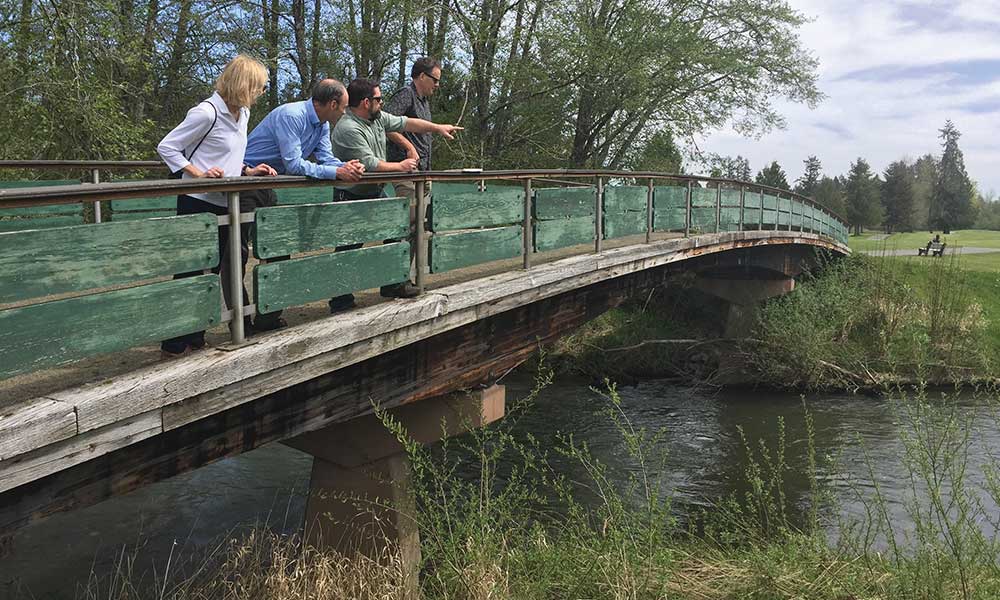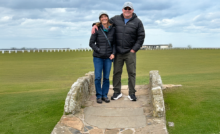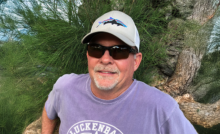Program Protects Salmon Streams on Golf Courses


The Salmon-Safe science team with Dan Smith of the City of Tumwater on a bridge spanning the Deschutes River at Tumwater Valley Golf Club
Stewardship Partners, a nonprofit organization based in Seattle, has grown into a model program that provides services and guidelines designed to restore and maintain salmon habitat in the Pacific Northwest. Just one of its campaigns is 12,000 Rain Gardens, which enables homeowners, schools, and communities to help prevent polluted runoff water from entering streams and rivers. Launched in 2011, that effort is halfway to its goal of 12,000 gardens.
The group’s overall intent is to reverse the steep ecological decline of Puget Sound, a large saltwater body that is home to many species, including orca whales and a variety of salmon, both of which are icons in this part of the planet.
Salmon are unique in that they live most the year in the ocean then travel inland to spawn in freshwater rivers and streams. The pink Pacific salmon range more than 150 miles – traveling 45 miles per day – where they spawn before dying. Atlantic species swim as far as 200 miles inland, then return to the ocean, often repeating this cycle several times. These truly remarkable creatures rely on centuries of instinctual patterns to sustain future generations.
Unfortunately, over the past 20 years, human encroachment in the form of dams, industrial pollution, conversion of forest land for development, polluted urban runoff, and harmful farming practices have degraded salmon habit, while threatening the food supply of Puget Sound’s resident orca pods, among the most-studied mammals in the world.
Stewardship Partners plays a role in helping restore salmon habitat by providing guidelines and certifying that farms, vineyards, and other landowners follow practices that protect water quality. Certification allows businesses to label their products and services as “salmon safe,” helping consumers make informed choices. To date, more than 95,000 acres of land have been Salmon-Safe certified, and more than 300 stores in the western U.S. promote such branded products.
Among the properties certified as Salmon-Safe are golf courses that contain salmon-bearing freshwater streams or border them. Puget Sound-area courses in the program include Druids Glen in Covington, Willows Run in Redmond, Tumwater Valley near Washington’s capital city of Olympia, and Salish Cliffs in Shelton. The Seattle organization also works with Salmon Safe, Inc. in Portland, Oregon, which has certified all the Rose City’s municipal courses: Colwood, Eastmoreland, Heron Lakes, RedTail, and Rose City.
Executive Director David Burger heads both Stewardship Partners and its Salmon-Safe affiliate. I conducted the following Q&A with David about the benefits and what’s involved for participating golf courses.
Jeff Shelley: What does certification cost?
David Burger: Salmon-Safe is a nonprofit and the typical fee for a golf course certification assessment is in the $20,000 range. That assessment fee covers all the costs of our independent science team and it’s the entire cost of Salmon-Safe participation over the five-year certification cycle, if applicable. Golf courses typically fund the assessment internally through marketing or operational budgets.
JS: Are there tangible cost benefits to certification beyond the proven benefits to salmon?
DB: Certification benefits depend on the golf course. But marketing and public recognition tend to be important one along with possible new environmental-management system input, operational efficiencies, and environmental-risk mitigation.
JS: Do operational costs increase with certification?
DB: Typically, operational costs would not increase under Salmon-Safe certification as areas beyond greens and fairways would be maintained with fewer inputs. Water conservation under Salmon-Safe certification also can result in significant cost savings. In some cases, there might be a decrease in labor with the reduction in pesticide applications.
JS: What about monitoring ongoing water quality?
DB: Water-quality monitoring requirements are outlined by our independent science team on a site-specific basis depending on the risk to downstream water quality. For a typical golf course, Salmon-Safe likely would require upstream and downstream monitoring on waterways going through the course. This would include testing for pesticides used on the course and, particularly, those listed as “high hazard” by Salmon-Safe. Also evaluated are nutrients that could leach from fertilizer applications, as well as turbidity and water temperature.
JS: Is it ever recommended that courses seeking certification test sediment or water for persistent products that may have been used in previous management of the course? If yes, could you share those examples with me?
DB: To date, testing for products used by prior management of a golf course or any site, for that matter, hasn’t been required by Salmon-Safe.
For more information, visit https://www.stewardshippartners.org/.
Jeff Shelley has written and published nine books as well as numerous articles for print and online media over his lengthy career. Among his titles are three editions of the book, “Golf Courses of the Pacific Northwest.” The Seattle resident was the editorial director of Cybergolf.com from 2000-15. For seven years he served as the board president of First Green, an educational outreach program that is now part of the Golf Course Superintendents of America and Environmental Institute for Golf.
Recent Posts
Memphis Country Club: A Golfer’s Study in Precision and Tradition
If you have ever teed it up at Memphis Country Club, you know this isn’t…
Foley Company attains GCSAA Silver Partner Status
Foley Company, a leader in turf equipment innovation and technology, affirms its support of the…
Harrell’s continues longstanding support of the GCSAA Foundation
Harrell’s LLC, a leading distributor of customized agronomic products for turfgrass since 1941, has donated…
City of Orlando Announces New State-of-the-Art Driving Range at Dubsdread Golf Course
The City of Orlando is excited to announce the construction of a brand-new, state-of-the-art driving…
Discover Puerto Rico for Great Golf Trips and After-Round Activities, Amenities
Golfers cannot live by the game alone which is why Puerto Rico provides the perfect…
Q&A with a Multi-talented Golf Course Architect – Part 2: Making the Rounds – Installment 39
This column features recollections of the author’s 37 years as a golf writer. These installments…


